If you’re headed to the Australian Outback and looking for some awesome things to do at Uluru and the surrounding area then you’ve come to the right place. This page will go over everything there is to do at Uluru-Kata Tjuta National Park and the other nearby national parks in the Outback.
Here in central Australia, people come from all over the world to catch a glimpse of the sun rising over Uluru (once known as Ayers Rock), the giant sandstone monolith that protrudes from the otherwise flat, red desert. Uluru is the largest single rock on earth and seeing it in person is a sight to behold. But there is more to this part of central Australia than just the monolith.
Kata-Tjuta is another massive sandstone rock formation and lies barely 25 miles away from Uluru. There is also Kings Canyon in Watarrka National Park and the beautiful gorges of Tjoritja / West MacDonnell National Park. This part of Australia is begging to be explored so read on so you’ll be aptly prepared for an awesome visit to the Outback!
Note: this article contains affiliate links, which means that should you purchase something or get a quote through them I may make a small commission at no additional cost to you. This helps keep the site running with up to date information. I do not represent World Nomads, Booking.com, GetYourGuide, or discovercars.com. This is information only and not a recommendation to buy the product mentioned in this article.
Uluru and the Outback – What You Need to Know
Where is Uluru?
Uluru is right smack in the middle of Australia. In the southern part of the Northern Territory state, you’ll find Uluru-Kata Tjuta National Park and surrounding parks.
The nearest city is Alice Springs, about a 5 hour drive northeast from the visitor’s center. The nearest major city is Adelaide, about 1600 km (1000 miles) south. So yeah, it’s really in the middle of absolute nowhere.
How to get to Uluru and the Australian Outback
If you’re not doing an epic Australian road trip the only way to get to Uluru is to fly into Alice Springs or fly directly to the Ayers Rock Airport right outside the park boundary. There are daily flights from Sydney, Melbourne and Brisbane to Alice Springs and daily flights to Ayers Rock from Sydney and Melbourne.
Uluru is about 4.5-5 hours from Alice Springs on a lonely desert road. You’ll ideally want to have your own car, as the only other option is to take a charter bus or to go on an organized tour. There is no public transportation option from Alice Springs.
For booking a rental car, check out discovercars.com, who usually has great rates in Australia. A rental car is the most affordable way to get to Uluru.
You also have the option to rent a campervan or an RV, which can be beneficial since freedom camping is legal in Australia. This means as long as you are outside the park boundary you can pull over anywhere and stop for the night.
There are plenty of freedom camping spots around Uluru and I recommend downloading the WikiCamps Australia app on your phone, which will show you all the free camping spots in Australia.
Charter buses run only a few times a week and they are not cheap at about $200 AUD each way. They also take a bit longer than driving yourself, usually around 6 hours. You can book a charter bus and check their schedules through GetYourGuide here.
Lastly, there are some organized tours from Alice Springs that last a few days and take you to all the parks mentioned on this page, though these are usually camping trips. There is one option to do a day trip from Alice Springs. Just note that that will be a really, really long day.
How long to stay
Theoretically, if you’re in a huge rush and skipping the other parks you could see Uluru and Kata-Tjuta in one day. There’s not actually that much to do in the park itself and if you’re not doing any hikes it’s easy to see everything in a day.
But you’ve come all this way, so why not enjoy it? I recommend 4-5 days for the three national parks, 6-7 days if you want a more relaxing experience. In general, a minimum of two days and one night is needed, though.
Weather in central Australia
Newsflash: it’s hot in the Outback. You’re 1000 miles from the nearest shoreline and it’s an endless desert. Summers can be brutal, with temperatures usually exceeding 40 degrees (104 F) and it hardly ever rains.
Winters are pleasant during the day – much more comfortable for hiking – but can get cold at night. It doesn’t rain much in winter either so skies are usually clear and blue.
Best time of year to visit Uluru and the Outback
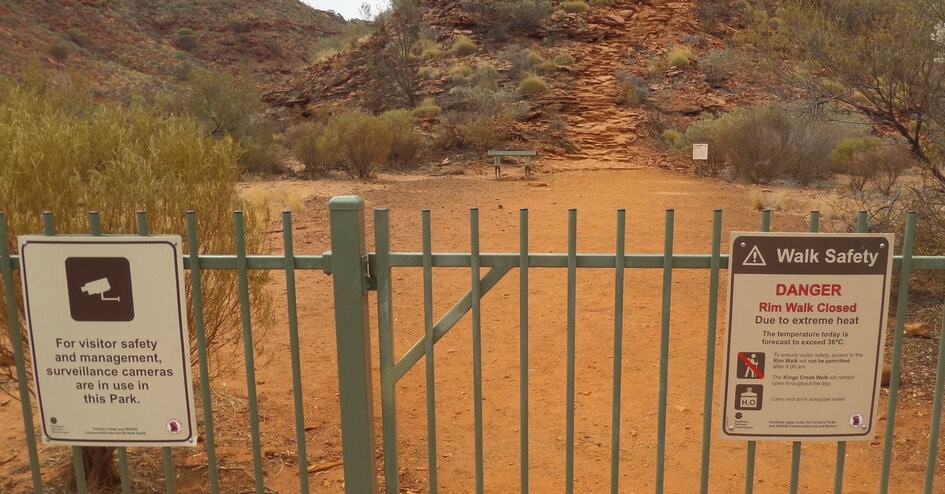
The best time of year for this trip will be mid fall. If you go in summer it can be uncomfortably hot but a lot of people do brave the heat. Winter is the peak time for the Outback, but days are shorter, evenings are colder, and it’s more crowded.
Due to the desert heat, many popular hiking trails are flat out closed in the late spring, summer, and early fall too. The Australian government mandates that trails be closed at 9 AM if the forecast that day is for temperatures over 36 Celsius (97 F), which is pretty much every day in summer. Even if the temperature never actually reaches the forecast, the trail is still closed.
If you go in the warmer half of the year all major hikes in the Outback will have to be done at first light. Mid Autumn is probably the best time to go for a combination of decent weather, hiking, and minimal crowds.
Aboriginal culture
This region of Australia is sacred to the indigenous people. There are many aboriginal cultural centers where you can learn about their beliefs and customs, including one in the park itself.
Wildlife
As you might have heard before, there is no shortage of animals in the Australian desert that can kill you with ease. There are poisonous snakes and spiders roaming around so you do have to be on the lookout, especially if you’re stepping off trail. Dingos roam the Outback as well. You’ll hear them at night but you probably won’t see them.
Red kangaroos call this region home and if you’re driving around you’ll probably see them hopping around here and there. They are most active at dusk and dawn so you have to be very careful about driving after the sun sets or before it rises. Do not speed and always be on the lookout.
You will see plenty of dead kangaroos on the side of the highways. While you may kill the ‘roo, it will surely damage your vehicle and ruin your trip. If you’re from North America, you can equate kangaroos to deer.
Flies in the Outback
It cannot be understated how many flies there are in the Australian desert. I have been all over the world and have never seen anything else even remotely like it (only comparison would be mosquitos in Alaska in summer). If your trip is in the warmer half of the year be prepared for flies all over you.
The flies won’t ruin your trip and should not be a reason not to go, but they will be incredibly annoying and you will be cursing them. These bush flies are found in the drier – I.e the Outback – parts of Australia and are attracted to moisture – i.e. your face. The only way to avoid them is to wait till the sun sets, as they stop swarming at night, or do the trip in winter.
Money
The currency in Australia is the Australian Dollar. You won’t really need any cash unless you’re camping, as many of the campsites will only accept cash payment. It would be good to have some just in case anyways. This trip will not be cheap. Just getting to Alice Springs could easily cost $2500 per person.
Once you’re there it’s not exactly cheap either. You are in the middle of nowhere and the prices reflect that. The best way to stick to a budget is to rent a campervan and cook your own meals as often as you can.

Travel insurance
When touring the vast Australian Outback, it’s advised to have travel insurance so that you’re protected in case of unexpected circumstances or illness. We use World Nomads when we travel internationally. Word Nomads provides coverage to travelers in over 100 countries. You can search for a coverage plan using the link below.
National parks
There are four national parks in this region: Uluru-Kata Tjuta, Watarrka, West MacDonnell, and Finke Gorge. Finke Gorge is small and more difficult to get to (only accessible by 4×4) so I won’t cover it in this post. While Uluru-Kata Tjuta is the crown jewel of Northern Territory, the other parks offer fabulous recreational activities as well.
Uluru-Kata Tjuta National Park
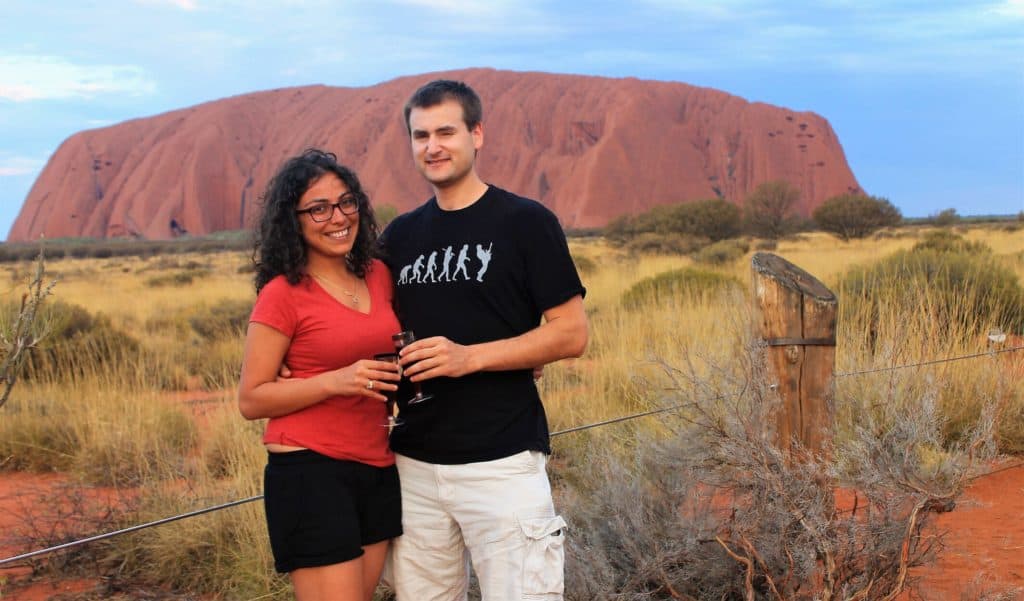
Uluru-Kata Tjuta National Park is one of the most iconic places on earth. Everyone has seen a photo of Uluru (aka Ayers Rock) at some point in their life. It’s the highlight of your trip to the Australian Outback.
But while everyone knows of Uluru, it’s not the only giant monolith in this heavily visited national park. Kata Tjuta, aka The Olgas, is a series of sandstone monoliths that sort of looks like a giant foot from above. The two distinct sections from the park lie about 40 miles from each other and there is not much in between. You can’t come here and skip Kata Tjuta, even if you’re never heard of it before.
Entrance to the national park will cost you $38 AUD per person for a three day pass. You can buy ahead of time online or pay when you arrive at the entrance station. It’s expensive, but compared to what you paid to get there it’s peanuts. Don’t lose your pass, since you’ll need it to enter the park each day.
It’s not possible to stay overnight inside the park boundary, so you’ll need to exit and reenter each day. So again, don’t lose that ticket.
The best thing to do at Uluru is to drive around to all the viewpoints and take some nice walks around the desert. There actually isn’t that much else there, so I’ve assembled the top things to see and do below.

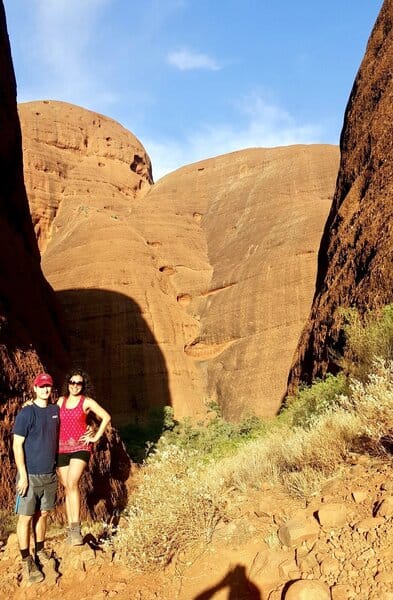
Viewpoints
- Uluru Sunset Viewing Area: Exactly what it sounds like, the best spot to watch the sunset over Uluru (will be very crowded).
- Uluru Sunrise Viewing Area: Again, self-explanatory.
- Field of Light Uluru: created by an artist and originally meant to be a temporary exhibit, this field of small lights is now permanent and lights up in front of the rock at night.
- Kata Tjuta Dunes Viewing Area: a great view of Kata-Tjuta over the sandy red desert floor.
- Ayers Rock Carpark: get up close and personal with the mammoth rock here. This parking area also serves as a basepoint for any exploration around Uluru on foot.
- Kata Tjuta Sunset Viewing Area: won’t be as crowded as Uluru’s sunset point.
- Kata Tjuta Carpark: the closest view of these rocks you’ll get without going on a hike.
There are many other good views you will get from the side of the road and it’s safe to pull over so long as you are completely off the road and on the shoulder.
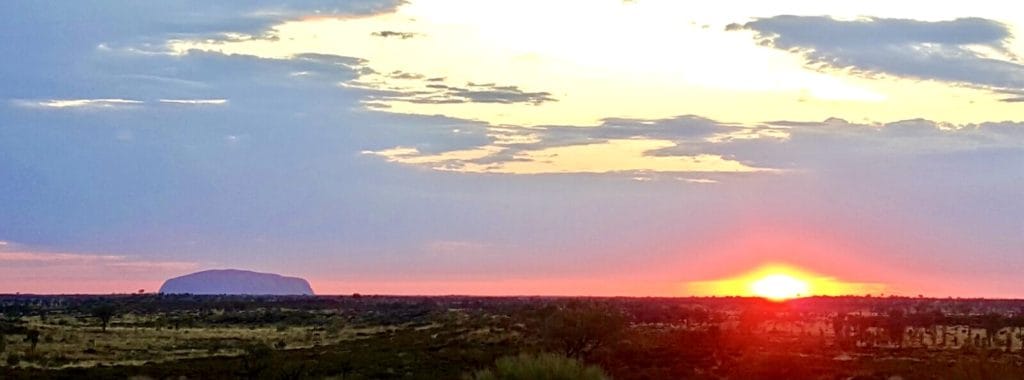
Hikes
Believe it not, there really aren’t many hiking opportunities here. The trail to the summit of Uluru is permanently closed so there is now only one possible hike at Uluru. Kata Tjuta has two additional hiking options.
Other than these three there is nothing else that can be considered a hike, just a few short strolls. You could theoretically do all three of these hikes on the same day if you’re fit enough.
Uluru Base Walk
The only hike at Uluru itself, this trail will take you completely around the monolith, offering you different angles to view the sandstone mountain. It’s totally flat, but don’t be fooled.
When it’s hot and the sun is shining it can be brutal. It’s 6.8 miles (10.9 km) in total and I highly recommend doing it. We barely saw anyone else on the trail, so peace and quiet can be found in this sacred place. Also note that if you have a mountain bike you can easily do this trail on your bike, as it does not have any steps or major elevation gain.
Valley of the Winds
This 4.5 mile (7.2 km) hike will take you up and around the funky sandstone formations of red rock at Kata Tjuta. If you start early enough you’ll be able to avoid the crowds. In the warmer half of the year the trail will close at 9 AM due to heat anyways (see discussion above) so be sure to get there in time.
Walpa Gorge Walk
A short trail that takes you through a massive gorge, this is probably the most popular hike in the park as it’s short and easy and offers some breathtaking views.

Other things to do at Uluru
- Uluru-Kata Tjuta Cultural Center (no additional fee): Take a break from the sun and learn about the history and culture of the aborigines who call this land home. There is also a nice shaded picnic area if you’ve packed your own lunch.
- Chris Hill’s Uluru Camel Tours: Stop by Chris Hill’s Uluru Camel Tours if you fancy a camel ride. It’s not a huge area where you get to ride. It’s not quite Egypt, but it’s neat to have a little ride with Uluru in the background.
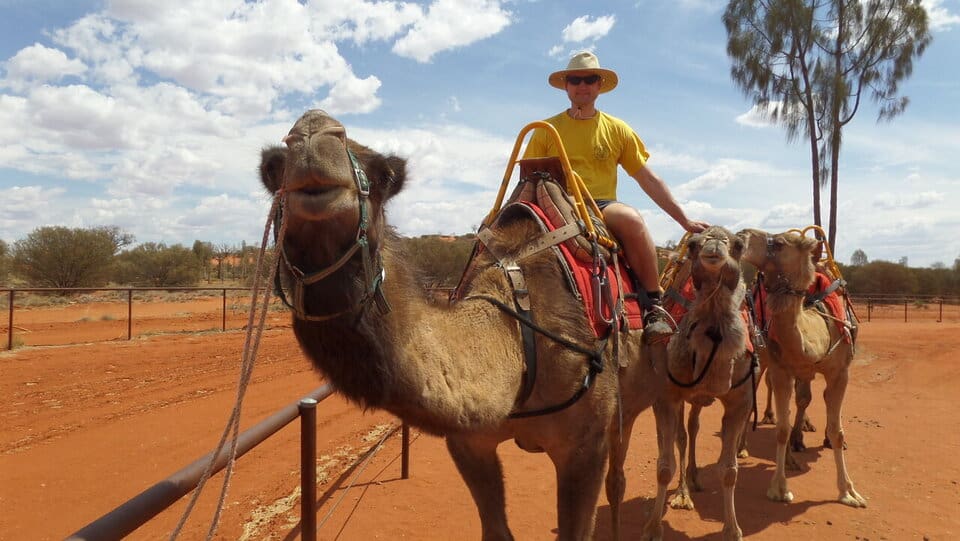
Where to stay at Uluru
There is a small tourist village just outside the park called Yulara that has all of the official accommodation options for the park. There are many lodging opportunities here from camping to fully serviced apartments to luxury hotels.
Everything in Yulara is managed by the Ayers Rock Resort. A tent site starts at about $40 AUD and the accommodation prices go up from there. The cheapest hotel is about $200/night while the most luxurious is about $600/night. Be sure to book well in advance.
If you are in a campervan or RV you have the option to stay for free at a roadside rest stop about 20 miles east of the park. I wouldn’t recommend it in a tent. There is also a gas station and cattle station a bit further east, Curtain Springs, but it would only be worth staying there your first or last night on your way in or out.
We also spent one night on the side of a dirt road west of Kata Tjuta when we couldn’t find the free campsite we had planned to stay at. I don’t really recommend doing that though.
Note that if you are doing the campervan option, it can be very hot in your van in this part of the country. You might be tempted to leave your van doors open but keep in mind there are dingos around.
Food
Like the accommodations, all the restaurants are managed by the Ayers Rock Resort. The restaurants are not cheap, but there are some cafes that offer menu prices that won’t bankrupt you. A full list of dining options can be found on the Ayers Rock Resort website. If you really want to live it up, opt for the outdoor dining and cultural experience of the Sound of Silence.
For the campers, there is also a grocery store in Yulara where you can get anything you need. If you’re coming from Alice Springs though, I’d recommend stocking up there where prices will be a bit lower.
Watarrka National Park
Watarrka National Park sits about 3 hours north of Uluru along the highway. This is a small park that is known for essentially just one thing: King’s Canyon. It’s much less visited than Uluru-Kata Tjuta and offers a different sandstone rock landscape. Here, instead of looking up to giant monoliths from flat earth, you actually look down to a canyon cut out of the rocky surface of the earth.
Hikes
There are only two hikes to do in the park, the King’s Canyon Rim hike and the Kathleen Springs walk. The latter hike is more of just a stroll. Like most good hikes in the Outback, the King’s Canyon Rim hike will close at 9 AM on hot days, so do not plan on only spending an afternoon in the park.
I wasn’t able to do the hike as I arrived in the park after 9 AM and had to settle for Kathleen Springs. Don’t make the same mistake I made. If you’re coming from Uluru you won’t reach in time to start the hike unless you leave really early. Plan on spending a night near the park and doing the hike the next morning.
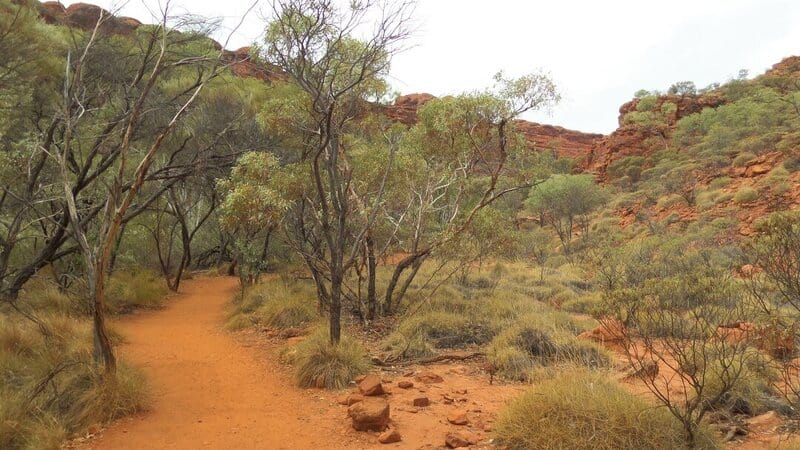
Where to stay at Watarkka
Similar to Uluru-Kata Tjuta, all accommodation and dining is managed by a single resort. Here it’s just a much smaller scale. The town of Peterman is tiny and everything is managed by The King’s Canyon Resort and Holiday Park. There are two option for staying near the park:
In general, the King’s Canyon Resort is far cheaper than Uluru and much less crowded.
If you’re looking to freedom camp, there is nothing really nearby. A few roadside pullouts can be found well north of Peterman though. Your best bet is to get there in the evening and pull over north of Peterman. You can then do the Kings Canyon Rim hike the next morning.
If you’re camping, head on to Tjoritja / West MacDonnell National Park, about 2-3 hours down the road. If you only stay in hotels, you’ll want to stay another night in Peterman and relax because there are no hotels or hostels near Tjoritja / West MacDonnell.
Tjoritja / West MacDonnell National Park
Tjoritja / West MacDonnell National Park runs nearly along the entire length of the MacDonnell Ranges, a small but rugged mountain range that runs through central Australia. The park is full of stunning gorges and red rock formations. It’s probably more known for the fact that it actually has some water though. Not really lakes, but small watering holes next to towering sandstone cliffs.
Hikes
If you’re up for another long hike set out on the Ormiston Gorge and Point Loop, which will take you through some lovely gorges and across some charming watering holes.
Or if you’d like to take a break from long hikes, bring your bathing suit and take a shorter walk to Ormiston Gorge, where you can take a dip in Ormiston pool. After a few days in the desert it will feel amazing. Some other places in the park to check out are Redbank Gorge, Ellery Creek Big Hole, Serpentine Gorge, and Standley Chasm.

Tjoritja / West MacDonnell has more hiking opportunities than the other parks in the area. If you want to check out some of the other hikes in the park, take a look at AllTrails.
A good change of pace would be to actually hike the summit of a mountain. You can do that on the Mount Sonder hike. Or if you truly want an epic adventure hiking across the Outback, the Larapinta Trail runs 139 miles from Alice Springs to the summit of Mount Sonder and takes at least two weeks. If you want to learn more about that you can check out this blog.
Where to stay at Tjoritja / West MacDonnell
There are no hotels near Tjoritja / West MacDonnell. If you’re not camping you will have to head on to Alice Springs for the evening. For campers/campervanners there are various options.
Ormitson Gorge, Ellery Creek Big Hole, and Redbank Gorge all have basic camping facilities. The sites are first come first serve and cannot be booked ahead of time. The park is usually not too busy, but there are limited campsites available, so best to secure a spot as early as possible. Cash is the only method of payment.
There are also numerous bush camping spots if you’re out on an overnight hike. The only place to get food in the park is the Taarna Kiosk, a little snack stand at Ormiston Gorge.
From Ormiston Gorge it’s only about 90 minutes back to Alice Springs, meaning it’s also very easy to visit Tjoritja / West MacDonnell as a day trip from Alice Springs. Remarkably, there are no hikes in the park that will close in high temperatures like the hikes in the other parks in the region, so there is no rush to get there and hike by 9 AM.
A Quick Note About Alice Springs
It’s possible to do this trip without going into Alice Springs, but if you’re flying in and out of there you’ll most likely end up spending at least one night in the city. It’s a small city, home to just under 30,000 people, which actually makes it the third most populated city in Northern Territory.
Alice Springs is sort of an Oasis in the desert and while there is not too much to do there compared to the neighboring national parks, it’s easy to spend a day bumming around the city.
If you want to see desert wildlife up close in a controlled environment and learn a little more about the desert, check out the Alice Springs Desert Park. For a nice view of the city and the red mountains that surround it, drive up to ANZAC hill.
If you’re up for trying some game meat, head over to the Red Ochre Grill for a camel burger. Australia is actually the only county in the world with wild camels. But they also farm them for meat. Tastes sort of like bison. Delicious!
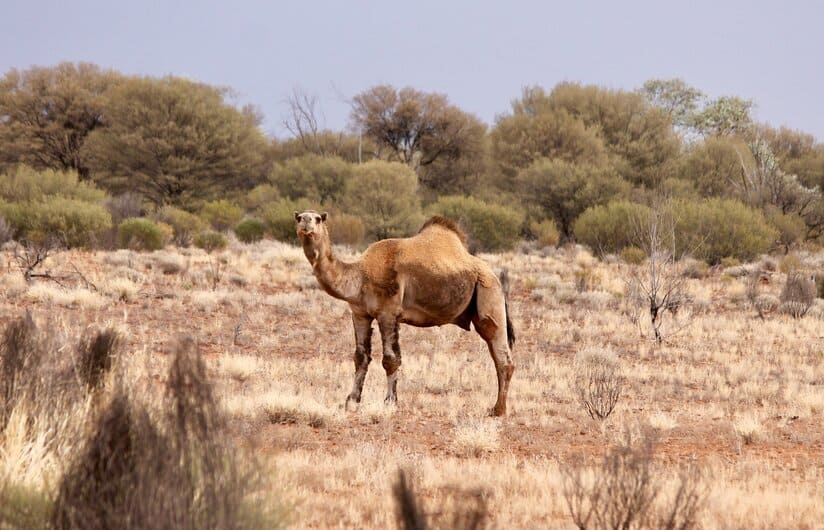
You will notice a lot of aboriginals loitering around the city. It’s good to know a little about the conflicts between European settlers and the aboriginals before you judge them. Long story short, it makes the way the settlers treated the native Americans seem peaceful.
Sadly, many of them have fallen into alcoholism these days and it’s best to not engage them on the street. To help out, you can buy an original painting from an aboriginal artist from most shops in town.
Uluru-Kata Tjuta – Frequently Asked Questions
Are Uluru and Kata Tjuta the same thing?
Uluru and Kata Tjuṯa share one national park but they are not the same thing. They are two different rock monoliths separated by about 25 miles of flat Australian desert. Uluru is the world famous monolith, one of the most recognizable sites on earth. While Kata Tjuṯa is little known internationally but arguably more interesting as it looks like fingers from above.
Why are tourists not allowed to climb Uluru anymore?
The trail to the top of Uluru was indefinitely closed in 2019 after years of objection from the aborigines of the area, who consider the monolith sacred and didn’t want people climbing all over it. However you might feel about this doesn’t matter. No one will ever be permitted to climb Uluru again.
What is special about Uluru?
Uluru is unique as it is the largest single rock on the planet. It’s also sacred to the local aboriginal natives and holds a special place in their culture and customs.
What does Kata Tjuta mean?
The literal translation of Kata Tjuta is “many heads”. Kata Tjuta is also known as “the Olgas”, named by German explorer Ernest Giles after Queen Olga of Wurttemberg.
Is Uluru a mountain or a rock?
Uluru is a rock. It’s a monolith, which is just a massive rock half buried in the earth. It’s the largest single rock on earth. Mountains are formed by movement of the earth when continental plates encroach on each other. That’s not happening here.
Things to do at Uluru – Final Word
The Australian Outback offers a unique travel experience that will leave you wanting more. The pure beauty of the red sand, monoliths, and rugged canyons will be the envy of your friends when they see your photos.
It’s not a cheap place to get to, but can be adequately done on a budget once you get there. I’m certain that you will have an awesome time at Uluru and the Australian Outback!


1 comment
Let’s do another Australian outback road trip soon!